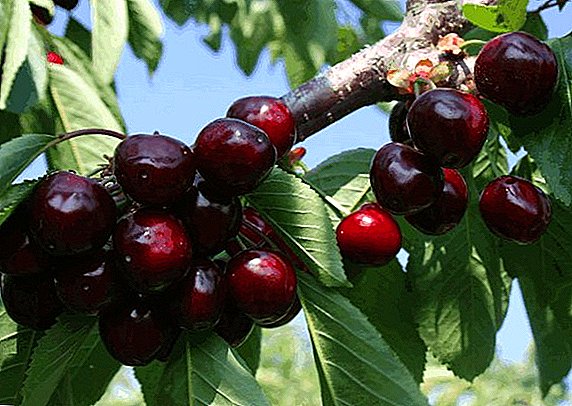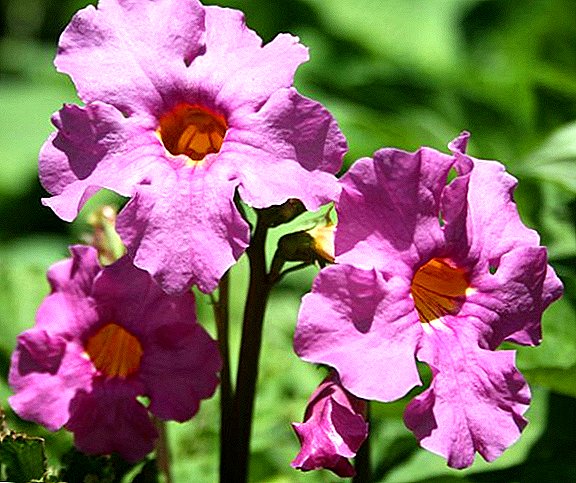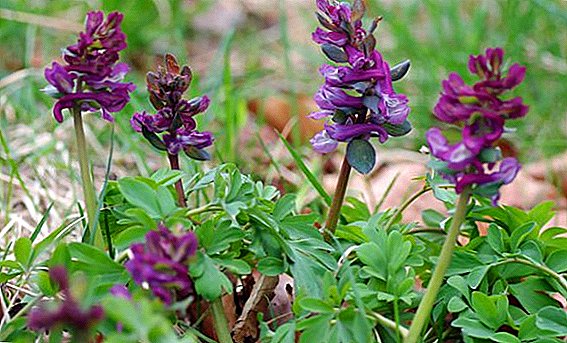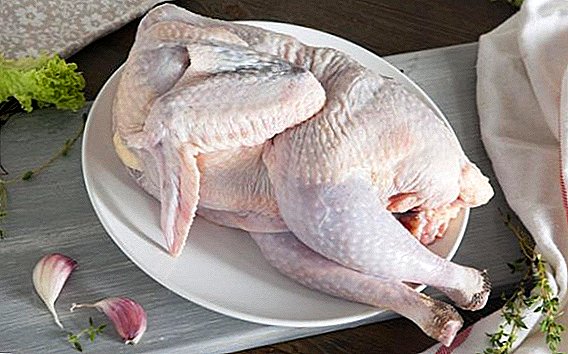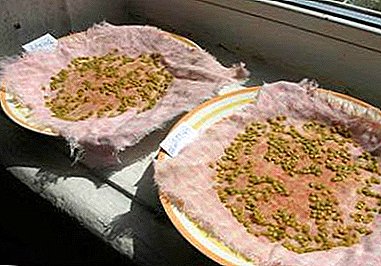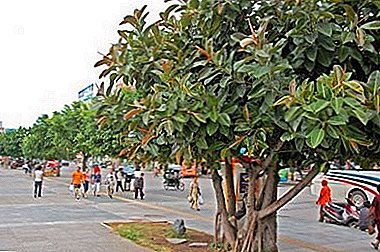
Tineke is one of the representatives of the variegated variety Ficus rubber, which is also known as Ficus Elastica or Elastic (Ficus Elastica "Tineke").
As the name implies, before it was grown to produce rubber, which was made from the plant's milky juice.
general description
Ficus elastica "Tineke" grows in the Indian tropics, where it reaches a very large size. However, in home ficus Elastica can reach two meters in height and more than a meter in width.
The leaves have a simple oval shape with a pointed tip at the end.
They are long (25 cm) and wide (15 cm), but smooth to the touch, with a pronounced central vein of a light green or pinkish color.
The external feature is the bright edge on the edges of these leaves, which forms a peculiar natural pattern.
It can be white, cream or have a green tint.
Tineke is not the only representative of rubber plants that have taken root in our homes and offices. On our site you will find detailed information about such types of it:
- Abidjan.
- Belize
- Black Prince.
- Melanie.
- Robusta
- If you need a bush, you have to pinch all the shoots at the height 10-15 cm After that, the lateral shoots will begin to develop and, when they reach the same length, they should also be pinched.
This applies to those shoots that are directed outwards.
Those that grow into the bush, you can not touch, and when the plant becomes too thick, you should remove some of the internal shoots to improve light.
- If the ficus pronounced vertical trunk, it can be turned into a tree.
To do this, all side shoots should be removed, leaving 3-5 topmost.
When the ficus reaches the desired length, you need to pinch the top and periodically cut the side shoots formed.
- Cutting lateral sprouts selectively, you can form a tree in several tiers.
- It is necessary to keep cuttings in water for about 2-4 weeks until the first roots appear.
The container should be placed in a light, but protected from the direct sun place, ensure 80% humidity and 25 degrees heat. It is important that the leaves do not touch the water, otherwise rotting is possible.
In the water, you can add a tablet of activated charcoal or charcoal. Cuttings with germinated roots are planted in light ground.
- Another rooting option - this planting directly into a loose and moist soil. This should be done immediately after drying the tip of the cutting, after having previously processed the cut with crushed coal.
The composition of the land should include the substrate, peat, sand and the mineral vermiculite or perlite.
For a container with planted cuttings, greenhouse conditions are created (placed under a plastic bag or under glass, for example, under a jar), not forgetting to regularly moisten the ground and open it to ventilate.
New leaves on seedlings will mean that roots have appeared, and young plants can be gradually accustomed to ordinary room conditions, increasingly leaving them open.
- The leaves of the plant are sluggish and loose. Lack of moisture, urgently need to pour ficus.
- The lower leaves turned yellow and began to fall. The soil is too wet, let the earthen coma dry and water less often.
- Ficus leaves fade, it grows weakly, new branches are deformed. Ficus needs fertilizing or transplanting.
- Part of the leaves of opal, on the remaining brown spots. The plant is cold, move it to a warmer place.
- On the underside of the leaves of ficus white woolly spots. It wound up a mealybug. Remove all pests with a sponge dipped in methyl alcohol or spray the plant with a systemic insecticide.
- Ficus leaves are covered with yellow specks, bottom of the cobweb. This indicates the appearance of a red spider mite. Spray with derris, malathion or systemic insecticide. It is also necessary to increase the humidity of the air.
- Under the leaves of the ficus and on its stems are flat brown growths. This is a scab. Remove pests with a cotton swab moistened with methyl alcohol or spray insecticide.
A photo





 All ficuses belong to a large group of decorative leafy plants. Among them, you can find a lot of very interesting specimens.
All ficuses belong to a large group of decorative leafy plants. Among them, you can find a lot of very interesting specimens.We want to bring to your attention the article about False Palms and Orchids.
Home care
Lighting
 Tineke loves light, but in the summer it is better to protect it from direct sunlight.
Tineke loves light, but in the summer it is better to protect it from direct sunlight.
On the whole, Elastic loves ambient lightingtherefore, the ficus with green leaves can be put not on the window sill, but next to the window.
However, the first time is to watch the plant more closely: if he does not have enough sun, the lower leaves will begin to turn yellow and fall off, and the patterned edge of the remaining will become less noticeable.
Because of this, the plant will lose its recognizable appeal, which will be quite difficult to restore.
In general, the care of rubber-bearing ficus is in many ways similar to the care of Benjamin ficus.
Watering
Watered with warm, settled water. Time for watering comes when the top layer of the earth dries out.
Most often they water it three times a week, but depending on the conditions of detention, the frequency may be different.
In winter, you can water only once a week.
Attention! The ficus loves water, but it is impossible to re-moisten the soil, as well as to overdry the earthen room, otherwise the leaves will be covered with brown spots and will begin to fall.
Humidity
Ficus Tineke loves moisture, so it should be periodically sprayed with soft water at room temperature.
This is especially important in the summer heat and in the winter when the batteries work. It is also recommended to carry out hygienic procedures for Elastics: weekly clean the leaves from dust with a damp sponge, and once a month arrange a warm shower for Ficus.
Crown formation
Tineke is growing rapidly, in the active period a new leaf appears once a week.
Also, the root system is rapidly developing, which has to be restrained by the tightness of the pot and periodic pruning.
As a result, it becomes a large shrub or even a tree.

Note! All cuts must be wiped with a damp cloth until the juice ceases to stand out, then sprinkle them with powdered charcoal.
In order for the plant to branch and develop as evenly as possible, it must be periodically turned towards the window with its different sides.
Soil and soil
Rubber rubber plant loves fertile, loose soil. Therefore, in the peat soil acquired in a flower shop, it is worth adding sod and leafy land, as well as a certain amount of sand and peat.
Fertilizer
Feed "Tineke" from March to September every one to two weeks. Fertilizers with a predominance of nitrogen are excellent for this.
Planting and transplanting
Tineke transplanted when the root system braids the entire clod of earth and the plant becomes closely in its capacity.
Transplant is best done in the spring or early summer with periodicity once in 1-3 years.
The pot should be chosen 2-3 size more than the previous one. Read also about the rules of transplantation of other types of ficuses.
Breeding
The best time for plant reproduction is spring: so young plants will have time to get stronger before the autumn and winter cold.
Tineke, like Benjamin, is propagated by cuttings. For this you need semi-woody cuttings approximately 10-15 cm long from the ficus tops. They need to be cut diagonally with a well-sharpened knife or a sharp blade.
Those 2-3 leaves that remain on the cuttings are cut to half and then rolled into a tube to reduce the evaporation of moisture, and the bottom sheet is cut off completely.
From the incision, wash off the juice, which prevents the formation of roots, then put the cutting in a container of water for an hour or two. Then the cut should be dried for several hours.
Further two options are possible:
Temperature
Tineke - heat-loving plant. The best temperature for him is from +18 to +25 degrees.
In summer, it can reach 30 degrees heat.
In winter, temperatures are acceptable. 15-16 degrees for young and 5-7 degrees for adult plants.
If the ficus can endure short-term frosts, then drafts and overcooling of the roots can harm it. Therefore you should not put his pot on a cold floor or window sill.
Diseases and pests
Diseases and pests that threaten Tineke are very similar to the adversities inherent in all the ficuses in general.
Conclusion
If you properly care at home for the ficus "Tineke" he will decorate any interior, as it is a very showy plant.
The only thing that can be difficult is to provide a potentially large plant with enough space to grow in height and width.
Useful video about ficus:


